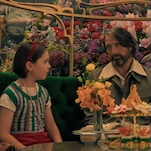The choice is harder than it was in Martel’s book, because here, the body is more compelling by far. Pi grows up in his father’s zoo, until his father decides to sell the animals and move his family abroad. When their transport ship sinks, Pi (played as a teenager by Suraj Sharma) ends up adrift at sea on a lifeboat populated by an assortment of animals, including a full-grown Bengal tiger. Director Ang Lee (Crouching Tiger, Hidden Dragon; Brokeback Mountain) executes all this with dizzying, overwhelming verve: The shipwreck in particular is a dazzling sequence, particularly traumatic in 3-D, and Lee stylizes a great deal of the more mundane storytelling as well. As with so much about Pi, it’s strikingly beautiful, but consciously artificial.
And so is the meat of the story, which has Sharma repeatedly, desperately trying to come to terms with his lifeboat companion in some way that doesn’t kill either of them. For much of the film, the metaphors at work are largely submerged in the immediacy of Sharma’s breathless, intense fight for survival, spaced out by moments of overwhelming visual richness provided by the changing environment around him. But the larger messages about spirituality often seem forced, and it’s more compelling to focus on Lee’s visceral cinematic experience than on the larger, fuzzier messages Martel’s story conveys about humanity’s connection with God. The tiger’s soul might make for a deeper, more compelling bit of fiction, but Lee renders its body so lavishly and lovingly that it’s hard to get past that surface.
For thoughts on, and a place to discuss, plot details not talked about in this review, visit Life Of Pi’s Spoiler Space.









































